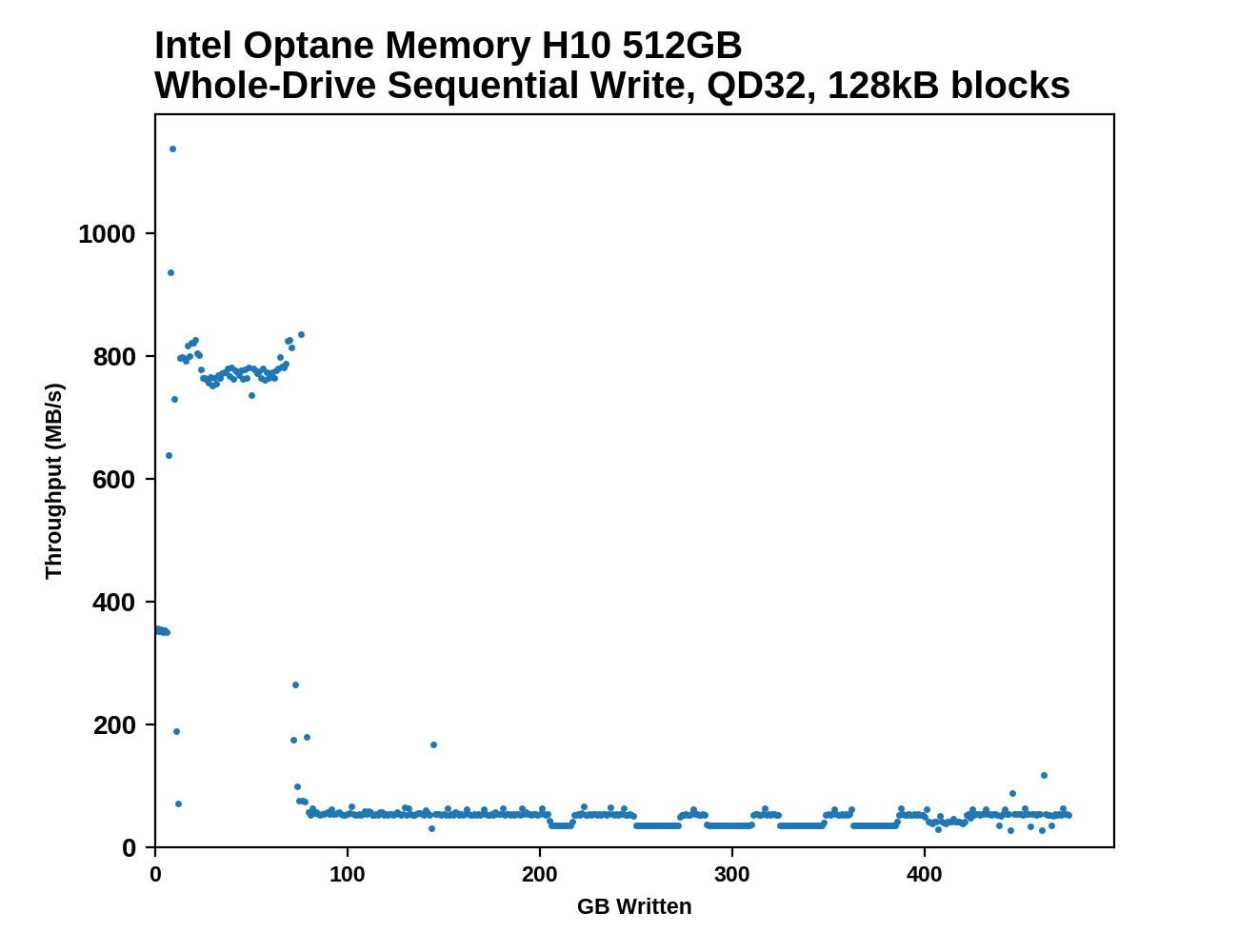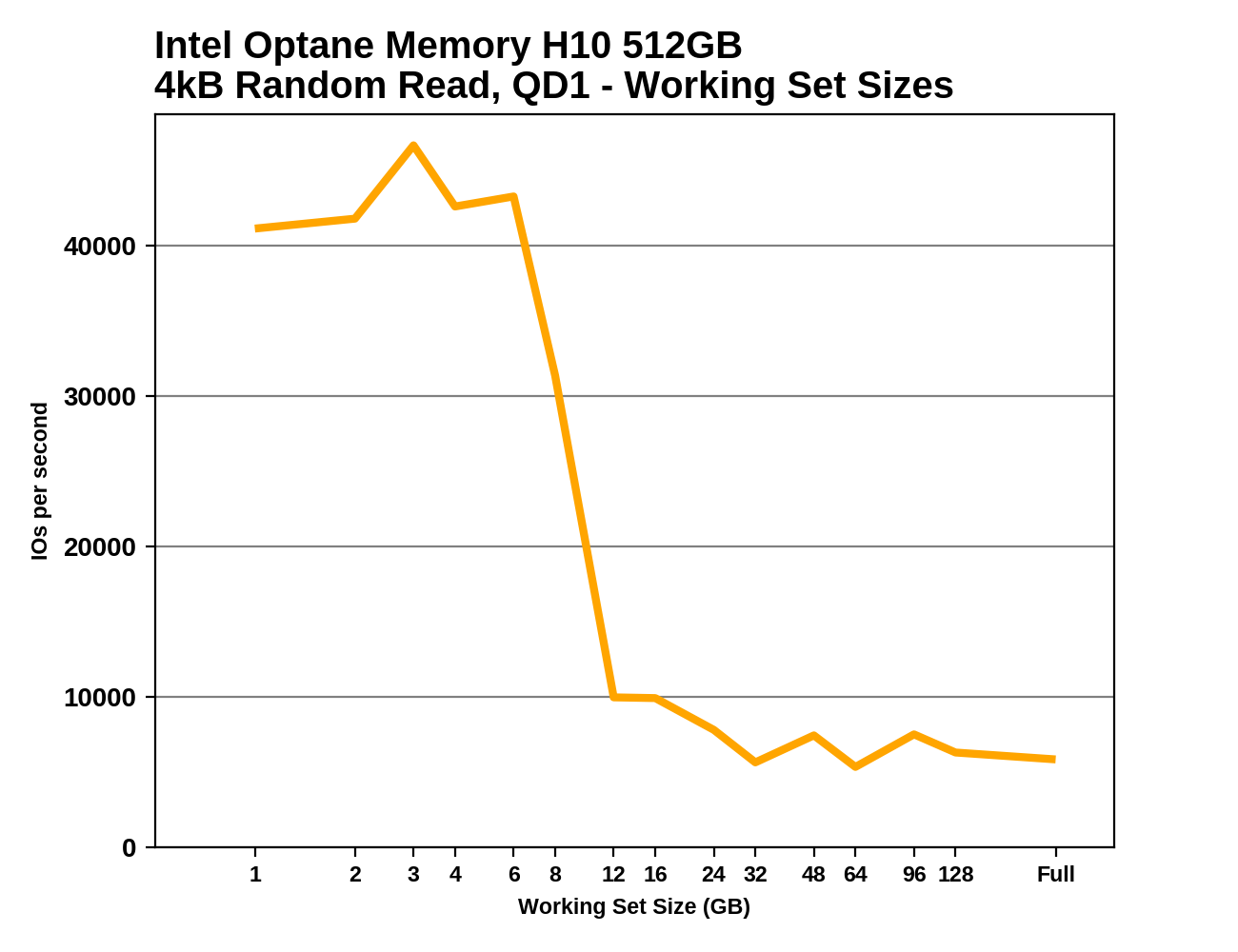The Intel Optane Memory H10 Review: QLC and Optane In One SSD
by Billy Tallis on April 22, 2019 11:50 AM ESTWhole-Drive Fill
This test starts with a freshly-erased drive and fills it with 128kB sequential writes at queue depth 32, recording the write speed for each 1GB segment. This test is not representative of any ordinary client/consumer usage pattern, but it does allow us to observe transitions in the drive's behavior as it fills up. This can allow us to estimate the size of any SLC write cache, and get a sense for how much performance remains on the rare occasions where real-world usage keeps writing data after filling the cache.
 |
|||||||||
During a sustained write, the Optane cache on the Intel Optane Memory H10 doesn't change the situation much from how the QLC-only Intel 660p behaves—the Optane cache on its own is only good for about 350MB/s. The SLC write cache on the NAND side is a more important factor that helps sustain high write speed far beyond the 32GB size of the Optane cache. But eventually, all the caches fill up and the very slow write speed of raw QLC takes over.
 |
|||||||||
| Average Throughput for last 16 GB | Overall Average Throughput | ||||||||
The overall average write speed when completely filling the Optane Memory H10 is unsurprisingly lower than any of the other drives in this batch. The 1TB Intel 660p was already a bit slower than a 7200RPM hard drive, and our H10 sample has half as much QLC to work with.
Working Set Size
 |
|||||||||
The Optane cache on the H10 is 32GB, but when testing random reads it appears to only be good for about 6-8GB working sets before the cache starts thrashing and performance drops down to roughly what a QLC-only drive can offer. It appears that Intel may be reserving a large portion of the Optane cache to serve as a write buffer, and this might be detrimental to the most read-intensive workloads.










60 Comments
View All Comments
Alexvrb - Monday, April 22, 2019 - link
"The caching is managed entirely in software, and the host system accesses the Optane and QLC sides of the H10 independently. "So, it's already got serious baggage. But wait, there's more!
"In practice, the 660p almost never needed more bandwidth than an x2 link can provide, so this isn't a significant bottleneck."
Yeah OK, what about the Optane side of things?
Samus - Tuesday, April 23, 2019 - link
They totally nerf'd this thing with 2x PCIe.PeachNCream - Tuesday, April 23, 2019 - link
Linux handles Optane pretty easily without any Intel software through bcache. I'm not sure why Anandtech can't test that, but maybe just a lack of awareness.https://www.phoronix.com/scan.php?page=article&...
Billy Tallis - Tuesday, April 23, 2019 - link
Testing bcache performance won't tell us anything about how Intel's caching software behaves, only how bcache behaves. I'm not particularly interested in doing a review that would have such a narrow audience. And bcache is pretty thoroughly documented so it's easier to predict how it will handle different workloads without actually testing.easy_rider - Wednesday, April 24, 2019 - link
Is there a reliable review of 118gb intel optane ssd in M2 form factor? Does it make sense to hunt it down and put as a system drive in the dual-m2 laptop?name99 - Thursday, April 25, 2019 - link
"QLC NAND needs a performance boost to be competitive against mainstream TLC-based SSDs"The real question is what dimension, if any, does this thing win on?
OK, it may not be the fastest out there? But does it, say, provide approximately leading edge TLC speed at QLC prices, so it wins by being cheap?
Because just having a cache is meaningless. Any QLC drive that isn't complete garbage will have a controller-managed cache created by using the QLC flash as SLC; and the better controllers will slowly degrade across the entire drive, maintaining always an SLC cache, but also using the entire drive (till its filled up) as SLC, then switching blocks to MLC, then to TLC, and only when the drive is approaching capacity, using blocks as QLC.
So the question is not "does it give cached performance to a QLC drive", the question is does it give better performance or better price than other QLC solutions?
albert89 - Saturday, April 27, 2019 - link
Didn't I tell ya ? Optane's capacity was too small for many yrs and compatible with a very tiny number devices/hardware/OS. She played the game of hard to get and now no guy wants her.peevee - Monday, April 29, 2019 - link
"The caching is managed entirely in software, and the host system accesses the Optane and QLC sides of the H10 independently. Each half of the drive has two PCIe lanes dedicated to it."Fail.
ironargonaut - Monday, April 29, 2019 - link
"While the Optane Memory H10 got us into our Word document in about 5 seconds, the TLC-based 760P took 29 seconds to open the file. In fact, we waited so long that near the end of the run, we went ahead and also launched Google Chrome with it preset to open four websites. "https://www.pcworld.com/article/3389742/intel-opta...
Win
realgundam - Saturday, November 16, 2019 - link
What if you have a normal 660p and an Optane stick? would it do the same thing?